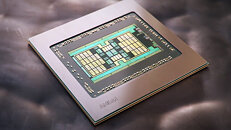- Joined
- Aug 19, 2017
- Messages
- 2,999 (1.07/day)
Back in February, NVIDIA has announced its GPU SKUs dedicated to the cryptocurrency mining task, without any graphics outputs present on the chips. Today, we are getting information that AMD is rumored to introduce its own lineup of graphics cards dedicated to cryptocurrency mining. In the latest patch for AMD Direct Rendering Manager (DRM), a subsystem of the Linux kernel responsible for interfacing with GPUs, we see the appearance of the Navi 12. This GPU SKU was not used for anything except Apple's Mac devices in a form of Radeon Pro 5600M GPU. However, it seems like the Navi 12 could join forces with Navi 10 GPU SKU and become a part of special "blockchain" GPUs.
Way back in November, popular hardware leaker, KOMACHI, has noted that AMD is preparing three additional Radeon SKUs called Radeon RX 5700XTB, RX 5700B, and RX 5500XTB. The "B" added to the end of each name is denoting the blockchain revision, made specifically for crypto-mining. When it comes to specifications of the upcoming mining-specific AMD GPUs, we know that both use first-generation RDNA architecture and have 2560 Stream Processors (40 Compute Units). Memory configuration for these cards remains unknown, as AMD surely won't be putting HBM2 stacks for mining like it did with Navi 12 GPU. All that remains is to wait and see what AMD announces in the coming months.

View at TechPowerUp Main Site
Way back in November, popular hardware leaker, KOMACHI, has noted that AMD is preparing three additional Radeon SKUs called Radeon RX 5700XTB, RX 5700B, and RX 5500XTB. The "B" added to the end of each name is denoting the blockchain revision, made specifically for crypto-mining. When it comes to specifications of the upcoming mining-specific AMD GPUs, we know that both use first-generation RDNA architecture and have 2560 Stream Processors (40 Compute Units). Memory configuration for these cards remains unknown, as AMD surely won't be putting HBM2 stacks for mining like it did with Navi 12 GPU. All that remains is to wait and see what AMD announces in the coming months.

View at TechPowerUp Main Site








